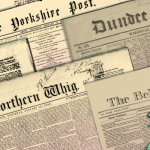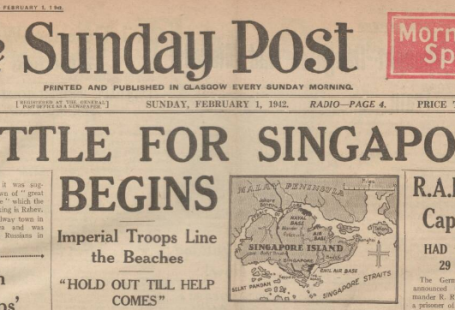Emma Willis explored the back streets of Birmingham, uncovered a violent ancestor, and revealed magnificent Irish craftsmanship in her family tree. In this week’s episode of Who Do You Think You Are?, we followed the lives of three of Willis’ ancestors: James Gretton, Richard Fowler, and Michael Kirwan. We will take a closer look at the newspapers and explore what more we can discover about the stories and lives revealed.
James Gretton
Emma Willis found out that her three-time great grandfather, on her paternal side, James Gretton, was a horn and hair merchant in Victoria-era Birmingham. A local historian explained that the profession was equivalent to selling hair brushes. In The Archive, we found that hair merchants also prepared and designed wigs.

As a second job, Gretton also produced glue, which consisted of boiling down the excess remains of animals, an unpleasant experience for others in the same vicinity. Due to the nature of his work, Gretton was brought up on charges of causing a nuisance. This did not refer to noise, but rather causing a public health risk. We have the full article that Emma Willis read about her ancestor’s case.

The Inspector of Nuisance, James Bliss, argued that Gretton caused a health risk, and local residents complained that ‘the odour from them was very offensive, and that sickness and fever were prevalent in the locality’. However, in Gretton’s defence, Mr John Suckling, produced a document signed by 100 residents asserting that no such disturbance existed and with further evidence given from a local surgeon accoucheur (a male midwife) who attended to the Gretton family. The surgeon testified that the family never incurred fever due to the processes of hair drying and animal matter. Furthermore, a nuisance complaint was raised with the adjoining premises and that may have been the cause of the fevers. The case was adjourned until the nuisance sited in the next yard could be investigated. However, the Birmingham Daily Post did not follow up with the complaint, and the outcome is unknown. Considering that James Gretton did not appear in the papers again, we can assume that the charge was dropped.
Richard Fowler
Continuing her family journey, Emma Willis was surprised to find Irish connections and set off for Dublin. There she met with an Irish genealogist who was able to trace her family back to the 1790s, a difficult feat for many tracing their Irish ancestry. Emma discovered the Fowlers were members of the landed gentry. However, the Protestant landed gentry were a minority among the large population of Catholic labourers. Sectarian tensions ran high in Ireland, especially in regards to land ownership–a conflict that continued through the 20th century. In searching for more about the Fowlers, Emma was given a newspaper article from the Leinster Express announcing the marriage of Richard Fowler, Esq. of Dunlavin, Wicklow, to Harriet Fisher of Merrion’s Town. We found the same announcement repeated in The Pilot and Wexford Conservative.

We also found Richard Fowler in the Dublin Event Packet and Correspondent listed on the register of freeholders. Fowler (number 44) owned a house and lands worth £10.

The British Newspaper Collection does not hold The Union Star or The Press, both papers that referred to Richard Fowler Sr’s violent and brutal attack on the Egan brothers discussed in the episode. The papers that The Archive holds from this time period usually focused on events related to Dublin rather than local events. However, if you want to know more about the United Irishmen, there are hundreds of articles available.
Michael Kirwan
In the third segment of Emma Willis’ Who Do You Think You Are? episode, the tv presenter discovered a celebrated Irish craftsman in her family tree. Michael Kirwan is Willis’ four times great grandfather. Kirwan was a well-known marble manufacturer who created ample Tabernacles and altar pieces for the new Roman Catholic churches being built in Ireland in the 19th century. At this time, restrictions against religious worship for Catholics relaxed, which lead to the construction of numerous Roman Catholic churches across the country.
We found 12 articles related to Kirwan’s work within the trade movement as well as references to a number of his creations. When Kirwan found success, he opened a wareroom or show room in Dublin. Regular newspapers announced the completion of a new work which would then be open for display at his wareroom until it would be installed in the intended church. His work can be found in Letterkenny, Down, Donegal, Dún Laoghaire, and Dublin. He even completed an altar and tabernacle for Cathedral Church of St Mary, Cape Town, South Africa. With each piece of art, he often used a combination of marble from Connemara and Tuscany.
‘From the celebrated Irish artist and marble works of Mr Michael Kirwan, Bolton-street, Dublin, whose skill does honour to his profession and country’. Belfast Morning News, 26 August 1859
Michael Kirwan’s work is a testimony to Irish craftsmanship and for that reason he was a well-respected member of the community. His death notice in The Evening Freeman stated that Kirwan was
‘the first to establish the marble altar building in Ireland, and in many of the Catholic churches in this city and the provinces, excellent specimens of his works bear testimony to his talent and industry in the art’.

Just a couple weeks before his death, Kirwan had received his final commission for an altar for the Roman Catholic church of San Fernando, Trinidad. This fact creates a fascinating connection between another WDYTYA alumni, Liz Bonnin. Bonnin’s ancestors established a church in San Fernando. Had Kirwan completed his final commission, would Willis’ and Bonnin’s ancestors have crossed paths?
Subscribe today and discover more about your ancestors









